Motorola Droid RAZR Review - A Better Clad Bionic
by Brian Klug on December 16, 2011 2:01 AM EST- Posted in
- Smartphones
- Droid
- LTE
- 4G
- Motorola
- Android
- Mobile
- Droid RAZR
- motorola droid RAZR
Cellular Connectivity
We’ve already outlined much of what there is to say about the combination of Qualcomm’s MDM6600 and Motorola’s on Wrigley LTE baseband inside the Droid Bionic review, but it still bears going over. Just like the Bionic, MDM6600 handles 1x voice and data, EVDO Rev.A 3G data, and Wrigley supplies LTE connectivity. In fact, the RAZR has a virtually identical cellular architecture to the Bionic, at least as far as I can tell. There’s the same Infineon transciever for LTE, Skyworks 700 MHz power amp, and combination MCP DRAM+NAND packages for the MDM6600 and Wrigley basebands.
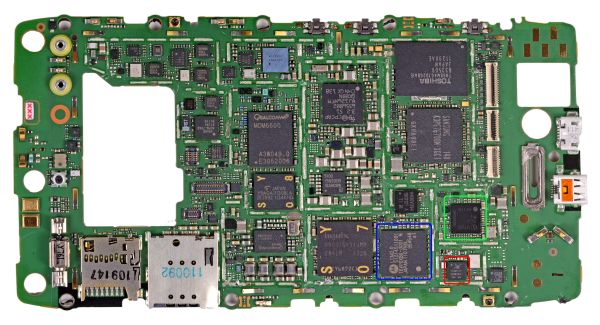
Motorola Wrigley LTE baseband, Intel/Infineon transceiver, Skyworks PA encircled in blue, green, and red respectively. (Original image courtesy iFixit)
I wasn’t totally satisfied in the Bionic piece that I proved the Wrigley baseband was UE Category 2, so I did some more poking this time with the RAZR and found the same exact architecture for administration and configuration as previously. Wrigley is actually a very interesting little part, consisting of an ARM926EJ-S running at 380 MHz:
cat /proc/cpuinfoProcessor : ARM926EJ-S rev 5 (v5l)BogoMIPS : 189.57Features : swp half thumb fastmult edsp javaCPU implementer : 0x41CPU architecture: 5TEJCPU variant : 0x0CPU part : 0x926CPU revision : 5Hardware : Wrigley 3G DatacardLTE
Oddly enough there are many places where it refers to itself as a “3G Datacard” even though it’s clearly designed only to work with LTE. The thing is just running GNU Linux:
uname -aLinux localhost 2.6.29-omap1 #2 Tue Oct 25 20:02:46 CDT 2011 armv5tejl GNU/Linux
The reality is that almost all black boxes inside mobile phones end up revealing something similar at their heart if you poke around enough. If we were counting the number of ARM parts onboard your average smartphone I wouldn’t be surprised to see at least 4 or 5 different ARM cores.
Anyhow, the RAZR doesn’t have a nice mib default xml file that nicely spells out the LTE UE category like the Bionic did, but the default set of mibs being set does include the Verizon EARFCN of 5230 which corresponds to LTE band 13. After lots of poking around, I found a way to query the UE category directly:
shell@(unknown):/system/bin$ iwaconfig -g -x 33163MOID 0x818b Name LTE_MGMT_RRC_UE_CATEGORY MIB OIDvalue=2 [0x02]
So life is good and our earlier claims that Motorola Wrigley (with lots of TI references inside) is indeed LTE UE Category 2. As a reminder, other devices based on MDM9x00, LG L2000, and Samsung’s CMC220 are UE Category 3.
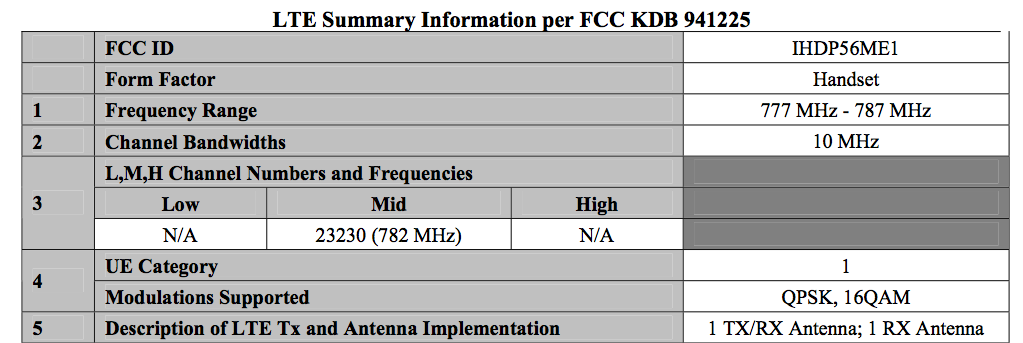
Oddly enough, just like the Bionic the official FCC filing summary information for the LTE side of the RAZR erroneously states that it is UE Category 1. As usual we get the normal pretty diagram with the location of antennas, and interestingly enough the LTE antenna is up at the top on the RAZR instead of in a combined module at the very bottom.
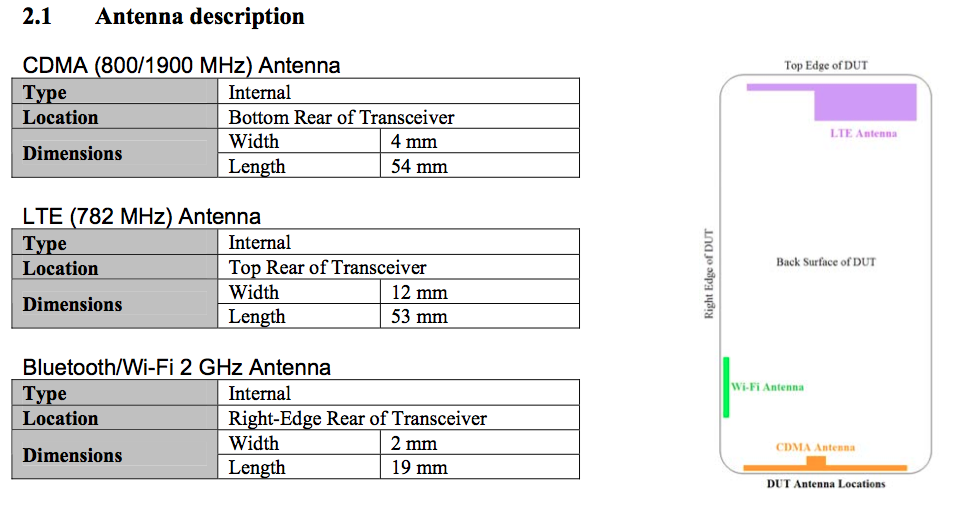
We’ve been doing a pretty good job keeping track of cellular throughput by running a bunch of speedtests, getting that data off, and making some graphs. The RAZR isn’t spared this treatment at all, and I ran 510 tests on Verizon 4G LTE in my own market in Tucson AZ and while on a trip to Los Angeles, CA.
Downstream Stats (Mbps)Avg: 14.701; Max: 36.267; Min: 0.068, StDev: 6.594Upstream Stats (Mbps)Avg: 6.912; Max: 20.719; Min: 0.084, StDev: 3.707Latency Stats (ms)Avg: 80.990; Max: 196; Min: 34, StDev: 17.499
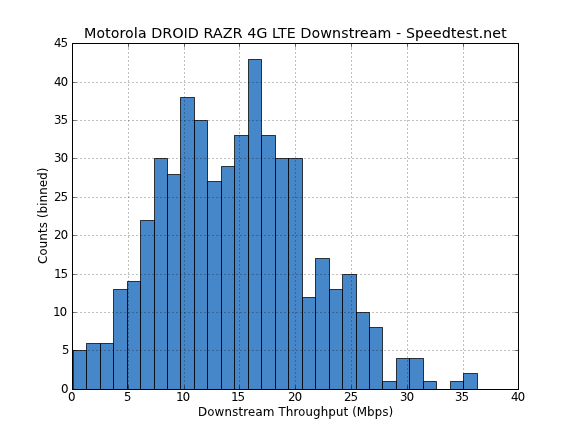
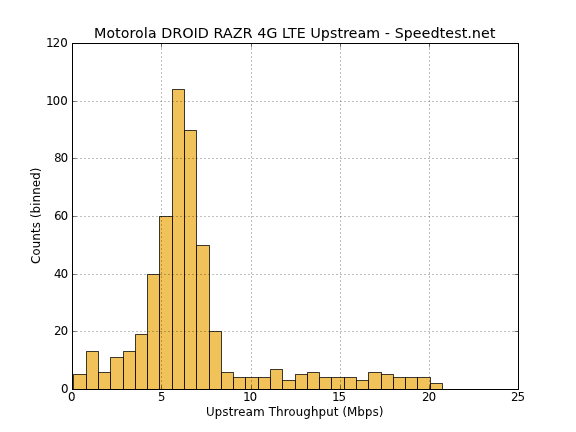
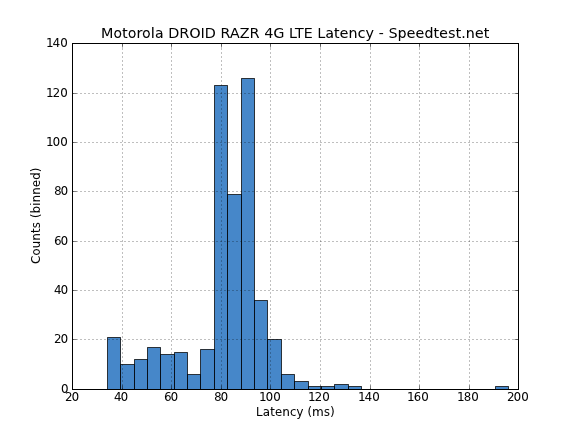
The histograms themselves look a lot like what we’ve seen already out of Verizon’s 4G LTE network on other smartphones, which again uses 10 MHz FDD on LTE band 13. I’ve seen numerous other people hit speeds above 50 Mbps on category 3 devices in favorable network conditions, but obviously the RAZR being category 2 does preclude it hitting those speeds.
Like the Bionic, the RAZR also gives you a nice and easily accessible network option to use either LTE/CDMA or just CDMA. Unfortunately again there’s no way to force data on only LTE and avoid handing over, but in practice I rarely saw the RAZR do a hard handover unless network conditions completely precluded using LTE.
I was pleased with myself when I used the Bionic that it was possible to look at LTE signal power (RSCP) and the channel quality indicator (CQI) by just running logcat and grepping the radio status daemon that Motorola wrote for updating their bar visualization. Unfortunately in this newer version of Blur that logging debug output and functionality is no longer, and if you look closely you’ll also notice they went from 4 bars to 5. There’s another way to view those metrics but it involves having shell on the baseband and directly querying the MIBs that correspond to all the LTE signal quality figures of merit. It’s still possible but much more involved. The upside of course is that I was able to confirm the RAZR correctly reports those bars based on signal power and quality, unlike most of the other LTE handsets which just look at power.
Lastly, the Droid RAZR XT912 Motodev page notes that the phone has WCDMA 850/900/1900/2100 connectivity courtesy of the MDM6600. However, the shipping Droid RAZR has WCDMA disabled and corresponding lines commented out inside build.prop for the WCDMA components. Considering the existence of the RAZR XT910 (sans “Droid”) with WCDMA and GSM I think it’s fairly easy to predict that a world mode variant with LTE is coming sooner rather than later. I wouldn’t mind having a RAZR that works on AT&T WCDMA, that’s for sure.










76 Comments
View All Comments
jjj - Friday, December 16, 2011 - link
It's not like you can buy any ICS devices yet ( the lack of SD on the Galaxy Nexus makes it a phone i wouldn't used if they payed me).The sad part is that it's not Krait or at least Tegra 3.As for when they'll get iCS and further updates,we'll see but it's doubtfull that any other manufacturer will be able to have faster updates that Googlerola.
zelachang - Friday, December 16, 2011 - link
How frequently do people really change out their SD cards? I have an OG Droid with 16 GB SD card from 2009 and I still haven't used up half the space. I wouldn't even consider multiple SD cards because I lose enough SD cards for my cameras, microSD cards would just fall in the couch or get eaten by my cats or something. When I first got my phone I thought I would end up swapping out cards a lot but for some reason I've never found a reason to.doobydoo - Tuesday, January 17, 2012 - link
Exactly, and even if you do run out of space you can simply plug it into a PC for 10 seconds, save all the documents, and continue.Or you could use Dropbox (on Android) or iCloud (on iOS) to completely negate the need for multiple SD cards unless you have unusual requirements.
Cali3350 - Friday, December 16, 2011 - link
I love your reviews, and I appreciate how in depth you guys go, but your reviews are getting increasingly more and more late and as a result less and less useful. This phone is over a month old at this point.I would love to see a Nexus review, but am assuming that cant occur until after Christmas, and that is not that helpful.
jeremyshaw - Saturday, December 17, 2011 - link
Quality. Anandtech beats all known in depth and thoroughness.doobydoo - Tuesday, January 17, 2012 - link
I actually agree with Cali3350, there is a point at which the quality becomes redundant if the phone was released so long ago. When a new phone is released, people don't want to wait over a month for a review, however high the quality - the most sales of any handset happen within that first month.I noticed the same thing happened with the iPhone 4S review, and made a comment to that effect at the time.
Quality is clearly excellent here, and this is definitely the best tech site - but by the time the reviews come out the article has already lost much of its value.
TrackSmart - Friday, December 16, 2011 - link
The Droid Charge review says the phone loses charge, even when plugged in, if using it as a hotspot. Same for navigating. This is a serious concern for me, especially when on-the-road.Are any of these LTE phones able to stay charged (when plugged in) while actively navigating or being used as a hotspot? I'm hoping you guys can weigh in.
I don't mind plugging in, while driving, but if I'm still going to have the phone die before my destination - that's bad news... Same regarding tethering over USB.
secretmanofagent - Friday, December 16, 2011 - link
I had the Bionic (swapped it out with a RAZR with all the data issues I was having), and I didn't have issues like I did with the original Droid. The original Droid would overheat and stop charging. I didn't have drain issues with the Bionic, haven't tried the RAZR yet.Brian Klug - Saturday, December 17, 2011 - link
The RAZR hasn't done the discharge-while-plugged-in dance the same as a bunch of other LTE phones. Navigation and hotspot use is fine on it, it'll charge while doing those activities if you use a charger that implements charging spec properly and has enough current.-Brian
TrackSmart - Saturday, December 17, 2011 - link
Thank you for the reply! This is comforting to hear. The Droid Charge article on Anandtech mentioned this problem and Engadget reported similarly on the Verizon version of the Galxy Nexus. That had me worried that this would be a more widespread problem.